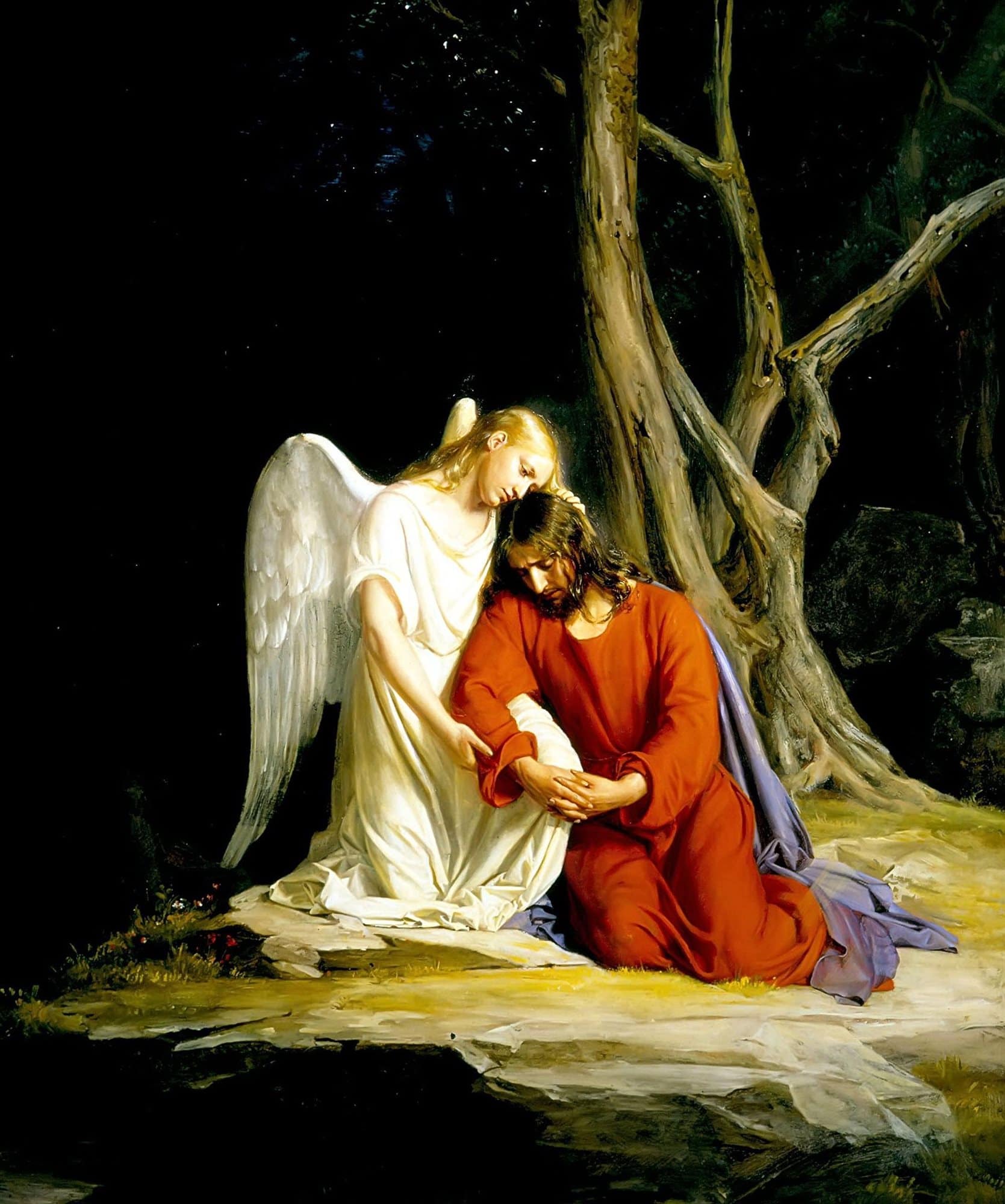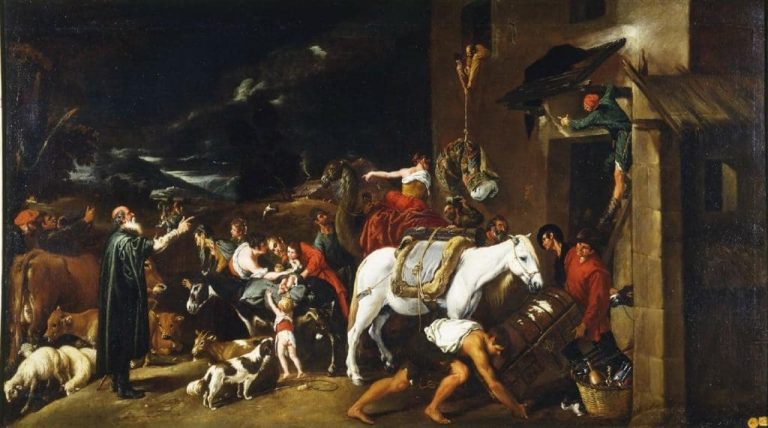What does the apocryphal Gospel of Judas Iscariot say?
Around 1970, documents dating from about seventeen hundred years ago were found in Egypt, an apocryphal gospel unknown to present-day humanity: the Gospel of Judas Iscariot .
This figure considered throughout history as the traitor, the one who handed over the master Jesus, has a different assessment in this gospel, revealing a facet of the apostle that no one knew.
If you want to know a little more about this document associated with the Gnostic sect of the Cainites, be sure to read this article.
What is the Gospel of Judas?
First of all, you should know that the term gospel comes from the Greek term euaggélion, which literally means good news or good announcement.
Gospel is called the books that collect part of the life and teachings or preaching of Jesus.
There are four canonical books or gospels that make up the New Testament, written by the evangelists Luke, Matthew, John and Mark, the only ones recognized by the Catholic Church.
However, recently, some very old writings appeared that suggest that there is another gospel, of an unknown author, and that it deals with Judas Iscariot, that disciple who in the biblical writings is known as Judas the traitor.
These texts presumably reveal information that until then was not known about the figure of Iscariot and his relationship with Jesus.
It is a document that is not considered by the church to be of divine inspiration, that is, it is an Apocryphal and is considered to be from the Gnostic New Testament, with Judas Iscariot being one of the central characters.
A single copy of the manuscript exists, which was found along with 3 other documents during illegal archaeological excavations in the cave tomb in the Karara Mountains in western Egypt, an area between the cities of Magaga and Beni Mazar, in the eastern bank of the Nile.
This gospel is a translated copy of a Greek writing probably by a scribe, which is presumed to date from the analysis of different samples of the papyrus and the leather cover, from the fourth century.
Radiocarbon analysis, paleography data, and a linguistic analysis all place the writing of this copy at some date between 220 and 340 AD.
While the original is estimated to date to some date between AD 130 and 150,
It consists of about twenty-six sheets, out of a total of 66 that make up the codex. The written text is organized in a column with an average of 26 lines per page.
It is contained in the already deteriorated fourth-century Coptic language codex along with three other works:
1- Epistle to Philip (Pp. 1-9); 2)
2- First Apocalypse of Santiago (Pp. 10-32) attributed to San Pedro.
3- The Gospel of Judas (Pp. 33-58)
4-The Book of Allogens (Pp. 59-66) this section of the codex is more damaged than others and the text differs from the treatise of the same name.
Part of the original binding has been preserved.
Jude in the New Testament
Judas, known as Judas Iscariot, is among the disciples chosen by Jesus during his earthly life.
Contrary to popular belief, this disciple is only once associated with the verb betray. On the other hand, the character is much more in the verb that means to deliver.
His status as a traitor comes from his role during the Passion: before Passover, he conspired with the Jewish leaders to deliver Jesus who, during the Last Supper, implicitly indicates it and announces that he will be delivered by one of the apostles, I will be delivered “by One of you”
Judas kisses Jesus to point him out to the Jewish leaders, he is arrested and after Jesus’ condemnation, he admits his sin, tries to make amends and rectify himself by returning the money to the Jewish leaders.
However, the gesture fails to change what happened and then he decides to hang himself.
In the gospels recognized by the church or canonical gospels, the figure of this apostle is negative, being considered purely and simply an evil, the most despised villain in history.
The apostle San Lucas relates:
“Satan entered into Judas, the so-called Iscariot, who was one of the twelve. And he went to speak with the high priests and the military chiefs about the way to deliver Jesus.
They were happy and agreed to give him money. Judas got engaged and was looking for an opportunity to hand him over hidden from the people” . (22:3-6)
Saint Matthew also relates in a passage that:
“When evening came, Jesus reclined at table with the twelve. And as they ate, he said to them, “Truly I tell you, one of you will betray me.”
Very saddened they began to say to him one by one: “Is it me, Lord?”
He replied, “Whoever puts his hand in the plate with me will hand me over.
The Son of Man departs, as it is written of him, but woe to him by whom the Son of Man is betrayed! It would be better for that man not to have been born!”
Then Judas, the one who was going to hand him over, asked: “Is it I, Master?” Jesus answered him: “You have said it” (26: 20-25)
These are some of the stories that mention Iscariot, just before handing over his master, told by two of the twelve disciples.
But why did Judas betray Jesus? There are several reasons given:
- He would have betrayed him for money, for greed, receiving thirty pieces for giving Jesus.
- For political reasons, Judas was considered a fanatic and wants to force Jesus to confront the authorities
- To complete the deeds finally.
Being this last thesis the one that is mentioned and developed in the apocryphal gospel of Judas Iscariot.
The apocryphal Gnostic text subverts the image of Judas contained in the canonical Gospels, describing him as a facilitator of Christ’s destiny and a faithful servant of his will.
Structure and content
The text of the Gospel of Judas in the Chakos Codex is not divided into chapters and has no subheadings, although in some places the scribe may have indicated the beginning of a new section with the help of a line and indentation.
The numbering and division of the text is according to the code pages and the lines introduced by the editors. They have thematic subtitles.
In volume, this Gospel is a small work and is comparable to the Passion narrative in the Gospel of Mark.
The apocryphon begins with a short prologue, which says that Jesus Christ gave a secret revelation in a conversation with Judas Iscariot within the week of the Passover celebration, about three days before his passion (Evang. Jud. 33. 1-14)
A similar introduction is found in the Nag Hammadi Apocrypha of John, where the mention of three days apparently determines the structure of the text.
Every day there is a conversation between the Savior and 12 disciples and his secret conversation with Judas. The first discussion with the disciples is devoted to the subject of the Eucharist (Evang. Jud. 33. 22-34. 10).
After her, Jesus speaks privately with Judas, and then leaves him. The second conversation begins the next morning when Jesus again appears to the disciples (36.11-37.20).
The conversation continues with a sermon in the temple concerning a vision that was shared by all twelve students at the same time (37.20-43.11) and ends with another secret conversation with Judas, after which Jesus departs.
In the third section, the longest, Jesus speaks only with Judas. An important part of the conversation is devoted to the creation of the world (47.1-53.7).
The ending briefly describes Judas’ betrayal: the high priests wanted to capture and arrest Jesus, but they were afraid of the people who considered him a prophet.
Judas Iscariot took the money and delivered Jesus into his hands (58. 9-26).
Language and dating of the monument
The Gospel of Judas Iscariot in the Codex Tchacos, is written in the Coptic Saidic dialect, a language with Middle Egyptian and Greek dialect influence.
Coptic, was a language spoken in Egypt at the time of the birth of Christianity, is related to the ancient Egyptian language.
It also uses the Coptic alphabet, made up of letters from the Greek alphabet and seven characters from the demotic script, which allow to represent some sounds that do not exist in the Greek language.
However, it is important to note that the original is presumed to have been written in Greek, since according to Coptic experts, this writing has twists and turns that reveal that it is a translation of a Greek document.
Greek is the original language of almost all Christian texts and writings that were written in the first and second centuries after Christ.
For this reason, most experts agree that the copy found in Egypt dates from the fourth century.
If this gospel is the same text that Irenaeus of Lyons is rumored to be talking about, its original appeared around the year 180.
A connoisseur of the canonical Gospels and the Acts of the Holy Apostles, he says that the Gospel of Judas is very likely to have been composed in the first century and that it was created by the Cainite sect.
It was written on papyrus, a flexible sheet made from the stem of an aquatic plant known as Cyperus papyrus.
The ink so far is supposed to be an old mix of ferrous sulfate, tannin, gum arabic, water, and carbon black or soot black (mostly carbon pigment).
The author of this gospel remains unknown to date and contrary to what many think, it is not Judas Iscariot who writes it.
The original Greek text, on which this translation was based, is believed to have been written after the four official canonical Gospels were produced.
Bishop of Lyons in Roman Gaul, Irenaeus, drew up a treatise known as Against Heresies.
In this material, any idea or message that was not approved or deviated from the line of orthodox beliefs of the Church was attacked.
One of the aspects he emphasized was the veneration of Judas Iscariot, the traitor, who remained among a group of believers who, according to Irenaeus, were the creators of a document known as “the Gospel of Judas” and which he claimed was a story lacking in truth. veracity:
“ It is said that Judas the traitor knew them very well and only he was informed of the truth, like no other, thus fulfilling the mystery of the betrayal.
Through him, all things, terrestrial and heavenly, led to dissolution. And they present an evidence called “Gospel of Judas” .
This allows experts to deduce that the original manuscript in Greek existed, while the copy belonging to the Coptic codex did not yet, because some decades before this was written, the outraged bishop already knew of the existence of the text called the Gospel of Judas. .
This angry bishop Irenaeus includes in his writing an extensive list of heresies that the church had to face, since by then there were already many groups that were inspired by the teachings and ideals of Jesus.
It is said that Irenaeus wanted to get rid of the teachings of cognitive Christians or those who had so-called cognitive aptitude.
Names like Marcion and Valentine, who claimed deep insight and open-mindedness, caused such beliefs to flourish during the second century, giving a new interpretation of Christian truth.
At that time, the first centuries of Christianity, the Church led by priests, bishops and other religious authorities was just one of the many groups that focused their teachings and experiences on Jesus Christ.
Among these groups are the Gnostics. From the Latin term gnostĭcus, gnosis means knowledge.
It basically consists of a doctrine that brings together philosophical and religious foundations, associating Christian and Jewish beliefs, Eastern religious traditions and aspects of Platonic thought.
The Gnostic affirms that through mysticism and intuition, the mystery of the divine can be accessed and known, since every human being has in its essence that divine power that is usually silenced or isolated from the divinity due to the defective material world where it does life.
Christians, such is the case of Bishop Irenaeus, affirm that only Jesus Christ, son of God, is both human and divine, while Gnostics firmly believe that any person could be united with God, because our essence is also divine.
Therefore, salvation for this group was only achieved if the divine essence of our spirit was rescued and awakened and connected again with God.
This of course was achieved, following the teachings of Christ the teacher who came to earth with that function, being able to become as divine as him.
Therefore the hostility of the orthodox catholic church and of Irenaeus as one of its representatives was very clear and marked. I consider these types of groups to be mystical and a challenge to institutionalized religion.
Many assume that this type of belief would leave the figure of some church authorities out of place and unnecessary, since they would no longer be needed as intermediaries between God and his people.
Some say that he who hears the voice of God within himself does not need a priest to function as an intermediary.
It is presumed that Bishop Irenaeus began the writing of his treatise, after returning from a trip and finding his faithful quite interested in the theories of a Gnostic preacher who was gaining more and more followers.
These so-called mystical groups were harshly criticized by orthodox leaders like Irenaeus and their doctrines were lost, except for certain things that were named by the church to be criticized.
But around 1945, in Nag Hammadi, Egypt, inhabitants of this locality found a hidden clay jar, where some Gnostic writings that had disappeared centuries ago were hidden.
More than a dozen writings where some hitherto unknown teachings of Christ were collected, including the Gospels of Thomas, Philip and the Gospel of Truth.
Presumably, they could have been much better known at the time than the versions of the current four canonical Gospels.
Many of these manuscripts or fragments written around the second century are copies of other Christian books, which early Christianity tried to hide and which has been emerging again for some time now, disturbing many quite traditional ones.
It is presumed that an anonymous scribe with his reed pen and a sheet of papyrus, made the translation, locating himself not far from the place of discovery.
It is believed that it was some monk from the monastery of San Antonio, a refuge located in the eastern Egyptian desert, about forty miles from the point.
It is said that many monks studied and venerated this type of Gnostic texts, keeping them in their libraries, but the intolerance of the Emperor Constantine, who only approved Christianity under the image of the organized church, was the reason that many considered it imprudent to have them.
At that time, at the end of the fourth century, the other Christian groups that did not belong to the traditional church and that had different views from the official ones, were seen as heretics, penalized, did not receive support and were banned and persecuted.
Therefore, many valuable documents that were not the four Gospels accepted by Irenaeus, such as Saint Matthew, Saint Luke, Saint Mark and Saint John, disappeared.
The influence of Irenaeus is felt in Egypt around the year 367. The bishop of Alexandria, the influential Athanasius, an admirer of Irenaeus, also issued a series of opinions and orders establishing the list of those documents that the Christians of Egypt should read.
Est contemplated some twenty-seven texts, among them the four current canonical Gospels.
These were considered the only sacred books and that list is maintained even today.
These provisions were the cause of the loss of a large amount of material, countless books disappeared and others were destroyed, while what is now known as the Bible was organized and shaped.
It is known that some were protected and hidden, an example of this were the books in Nag Hammadi found inside a tall clay jar, it is presumed that by the monks of the monastery of San Pacomio, which was very close to the place where they were found.
Another example was the codex that groups other Gnostic texts, including the Gospel of Judas.
Many of these documents survived for many centuries, wars and catastrophes.
When found, they were turned over to black-market dealers, vanishing into the underworld of antiquities dealers, one of whom abandoned him for sixteen years in a Hicksville, New York, bank vault.
This text was the object of several commercial transactions before reaching the hands of specialists who carried out its difficult restoration and publication.
By the time it reached their hands, the papyrus was disintegrating from time and handling, and its message was about to be lost forever.
In May 1983, Stephen Emmel was contacted to travel to Switzerland to carry out an analysis of some old Coptic documents that someone had for sale.
Already in Geneva, Emmel accompanied by other experts held the meeting, which was held in a hotel room.
Meeting with an Egyptian gentleman and a Greek who served as an interpreter since he did not speak English, they were allowed to review the document for half an hour to verify the content.
Kept in three shoe boxes, the papyri were wrapped in newspaper and some were falling apart, the merchants did not allow taking pictures or taking notes.
The experts who did not dare to touch it with their hands, used some tweezers to lift the pages and realized that they had before their eyes unpublished, important documents that mentioned Judas.
The deal was not carried out, Emmel could only offer about fifty thousand dollars, but the merchant expected about three million dollars, a high amount that was unaffordable.
The now professor at the University of Münster, Germany, wrote down the data he remembered from the beautiful papyri, which he lost sight of for seventeen years.
The current owners of the Gospel of Judas said the Egyptian they met at the Geneva hotel was a Cairo antiquities dealer named Hanna who bought the manuscript from a local dealer who located antiquities.
Obviously, where this deceased trafficker acquired the collection is unknown and his family and close friends remain reluctant to reveal the place where it was found.
When Hanna acquired the manuscript, she decided to take it out of the country along with other items, however it was stolen before she could do so and her sources indicated that her belongings had been moved out of the country illegally.
They were in the hands of another antiquarian, until Hanna managed to recover them, this also included the codex.
Hanna, in an attempt to make the most profit possible, since she was already aware of the great value of the collection, travels to New York looking for a buyer, however, she could not specify anything and returned to Cairo.
But first, he rented a safe deposit box at a Citibank branch in Hicksville, Long Island, where he kept the codex and other papyri.
Intact and moldy, they waited while the merchant tried to sell them, but the transactions did not bear fruit because the price was too high.
The sale takes place in April 2000, with a successful Greek businesswoman from the world of antiquities, Frieda Nussberger-Tchacos, who studied Egyptology in Paris. The woman never revealed the exact amount of the purchase.
The material was entrusted to an expert professor named Robert Babcock, who classified it as a unique and incredible material and presumed it was the Gospel of Judas Iscariot.
The Beinecke Library kept the document under its power for five months and then did not want to buy it, since there were still doubts about its origin.
Tchacos’s next conversations were in Ohio, with Bruce Ferrini, a former opera singer who was now selling ancient manuscripts.
The deal was closed, however it was not as reliable as expected and Tchacos required Mario Roberty, a Swiss lawyer who runs an antiquities foundation and therefore is knowledgeable about this world.
Fascinated by the story of the businesswoman, he offered to help her recover the manuscript and for this the lawyer allied himself with a well-known former dealer in the area of antiquities named Michel Van Rijn.
He currently runs a very influential web portal, from where he whips the enemies of the world of antique dealers.
With the information provided by the lawyer, Van Rijn revealed that there was a so-called Gospel of Judas, adding that it was in the possession of the merchant Bruce P. Ferrini.
This would seek to sell it due to its serious financial problems and with a threatening attitude warned those who were interested in buying it, that if they acquired it they would face justice.
This action was decisive so that in February 2001, Tchacos once again had in his possession the codex that included the Gospel of Judas and which was transferred to Switzerland.
Five months later the meeting with Kasser took place, who commissioned him to begin to decipher the meaning of the codex fragments.
The solution to the problem of the origin of the material was to sell the rights to broadcast and translate it, promising to return the original document to Egypt.
Lawyer Roberty’s foundation, Fundación Maecenas para el Arte Antiguo has control of the manuscript and was the one who signed the agreement with the National Geographic Society, this freed Tchacos from anything related to marketing.
In Switzerland, on the shores of Lake Geneva, is located the place where specialists try to reconstruct the papyrus and recover its content.
Frieda Nussberger-Tchacos, passionate about antiquity, had bought some stolen pages in 1999 and then the following year, she acquired the remaining part.
Excessive handling and the various vicissitudes of purchases, incredibly damaged the manuscript, in April 2006, after a long restoration and translation work, National Geographic presented to its public the transcription of the so-called Tchacos Code.
The National Geographic Society showed a complete translation of the text, with references and comments. It was a great job of restoring and maintaining the code.
Coptic specialist Rudolph Kasser played a major role in the translation effort.
His team was the one who managed to reconstruct most of it, almost 80% of the manuscript after five years of hard work, because many parts were very damaged and some pages were also missing, which were sold on the black market.
Professor Rodolphe Kasser, 78 years old, is one of the most recognized and accredited specialists in Coptic worldwide, in charge of the famous Gospel, he translates the first line: Secret Chronicle of the revelation made by Jesus in conversation with Judas Iscariot.
The scholar considers beautiful and interesting a document that after thousands of years, makes a despised man reappear through history in a different way.
The one who was among the favorite friends of Jesus, one of his apostles, who handed him over to the Romans for thirty silver coins and marked him with a kiss.
The story of Judas Iscariot transcended time and is the symbol of betrayal for Christianity, being the object of contempt and repulsion, but it takes an unexpected turn with the appearance, restoration and translation of this material.
However, there was an important detail that was not clear, the team did not know for sure if the text was authentic.
It was the appearance of an Egyptian marriage contract that confirmed the authenticity of the manuscript.
The discovery of a study of the Louvre Museum on marriages in Egypt and land contracts, which were from the same period and presented an ink in their writings similar to that used in the Gospel of Judas, confirmed that the document is authentic.
Joseph Barab was the head of the scientific team organized in 2006 by the National Geographic Society to determine if the Gospel of Judas was an authentic document.
This scientific team determined and concluded that:
1-The Gospel was written in the third or fourth century.
2-It is an authentic document, for the simple reason that due to the type of ink used, it could not have been a medieval forgery.
This is supported by the finding of marriage and land grants dating from the Egypt of those centuries (between I and III after Christ), which were written with the same type of ink.
3-They estimate that this document dates from a date between 130-170 AD. C and it is believed that the original text was written in the common Hellenistic language and the copied manuscript found was necessarily a copy of it.
The Gospel of Judas is one of sixteen Gospels attributed to the early Christian Church, which possess independent historical evidence of its existence. It is estimated that there are about fifty different Gospels.
In this case it was Bishop Ireneo del León who gave evidence of its existence, as well as some other ecclesiastical scholars, Tertulliano and Epifanio de Salamina.
In his texts that attacked the different beliefs or sects of the time, he indicated the existence of a document where Judas was vindicated: “Those who support this possibility support the traitor. Judas, telling us that he is admirable and great”
Some indicate that the Christian Church of the time succeeded in preventing many of these mystical Gospels from being known and spread, since it never considered them part of its central religious core.
The heretical Gospel of Judas was also included among the material of cognitive Christianity and lacked official Christian faith, maintaining many dogmatic differences with respect to it.
This manuscript is currently preserved in the Coptic Museum in Cairo. Specialists believe that the figure of a Judas, reborn, has been revealed and has come to light.
What does the Gospel of Judas say?
The Gospel of Judas is a document that shows some conversations and teachings that Jesus offers his disciples.
Below are some of the fragments of the translation, it should be noted that even when it was explained that it does not have subtitles, we tried to organize it this way for a better understanding:
thanksgiving prayer
The text explains that Jesus joins his disciples in preparing for Easter. Christ laughs at them:
The disciples said (to him), “Master, why do you laugh at (our) prayers of thanksgiving? We have done what is right.”
He answered and said to them: “I am not laughing at you, you are not doing this because it is your own will, but because this is a means that your god (will) be praised.”
They said: “Master, you are (…) the son of our god”
Jesus answered them, “How is it that you know me? Truly I tell you, no generation of the People who are mixed with me will know me.”
The displeasure of the disciples
This dialogue, which is missing words and lines, shows a Jesus, as many experts say in the document, somewhat casual. However, it caused annoyance among the disciples:
“When the disciples heard this, they became angry and angry and began to blaspheme against him in their hearts.
When Jesus observed their lack of understanding, he said to them, Why has this discussion caused you to be upset? Your god of yours is within you”
Private conversation with Judas
The text also mentions certain dialogues between the master Jesus and his disciple:
” Knowing that Judas was reflecting on something, because he was excited, Jesus told him, “Get away from the others and I will tell you the mysteries of the kingdom.
It is possible for you to reach them, but you will aggravate the great pact (36) for any other that replaces you, in order of the 12 disciples will come to them the complementation with their god “ .
Jude’s fate
Among the revealed fragments of this apocryphal document is where Judas asks the teacher Jesus about the future that lies ahead:
“Master, could it be that my seed is under the control of the judges?”
Jesus answers him and tells him, “Come on, I (there are two lines that don’t exist) but you will be offended when you see that the Kingdom is coming and all its generation”.
When (Judas) heard this, Judas said (to Jesus), “What good is this that I have received, by which you have set me apart from this generation?”
Jesus answered him and said: “You will become the thirteenth and you will be cursed by the other generations – And you will rule over them, in the last days they will curse you for your promotion to the blessed generation…
Perhaps one of the most controversial fragments of the text, for those more traditional.
Many specialists indicate that if true, this would leave Christianity without its traitor, the one on whom the blame fell, alleviating for many the responsibility of Pontius Pilate and the Romans in history.
Come on I will teach you about (secrets) that no person (has) seen before.
By them there exists a great and limitless Kingdom, the extent of which no generation of angels has seen, (in which) there exists a great invisible spirit which no eye of an angel has seen before, nor the thought of the heart has ever comprehended, and never was. called by no name…”
Jesus is handed over to the chief priests
This Gnostic gospel ends when Judas finally betrays Jesus, without mentioning anything that happens later, that is, the passion, death and resurrection of Christ.
This excerpt relates:
“(…) The high priests murmur because he has gone to the guest room to pray.
The scribes were watching him carefully to later arrest him during prayer, but they were afraid of the people, since he was received by all as a prophet.
They approached Judas and said to him: “What are you doing here? You are a disciple of Jesus. Judas answered them as they wished, and he received a money and they handed it over to them.”
Jesus thanks him, as he prepares the moment when he will be “released” from the body, allowing him to return to the “great and limitless kingdom whose immensity no generation of angels has seen.”
According to Gnostic teachings, the body is seen as a prison for the soul, since the divine spark that exists in every human being aspires to return to the divine.
The text speaks on certain occasions of another “generation”, which carries the “divine spark” and is therefore called allogeneic.
This is the superior generation to which Judas and Christ according to the texts belong, in contrast to their other apprentices (disciples) and the Christians of this generation.
This document shows us a different version of Judas, far from being the symbol of betrayal of Christianity.
He allows himself to be seen as the one who clearly understands the message of Jesus Christ and fulfills his mandate to deliver it to the Roman authorities, even being warned of what his destiny and memory in history would be.
It is undeniable that it represents a total opposition to the New Testament, at a dogmatic and discursive level.
He presents Judas not as the traitorous disciple who betrayed Jesus, but as one of his texts indicates, the man who redeems God from his corruptible body and allows him to return to his origin, his divine status.
However, many scholars in the area argue that this document known as the Gospel of Judas is an amazing archaeological discovery of immense cultural interest.
A text that provides a different vision of the relationship between Jesus and Judas, without overthrowing the sacred beliefs of Christianity.
It simply enriches our knowledge of the theological insights of the time and the religious controversies within the Christian tradition.
The Tchacos codex
Also known as the Minya codex because of the site where it was discovered in Egypt, the Tchacos codex contains, among other writings, the Apocryphal Gospel of Judas or the book of Judas Iscariot.
This codex known by the name of Tchacos, after its last owner, the art dealer Frieda Nussberger-Tchacos, who sold it to the Fundación Maecenas of Geneva (Switzerland).
It is written in Coptic, on papyrus, and probably dates from the fourth century after Christ.
Its discovery in Middle Egypt in 1970 joined that of the Nag Hammadi or Upper Egypt papyri in 1945, an important Gnostic library or archive.
The Tchacos code contains exclusively works of cognitive Christianity, such as the “First Revelation of Santiago”, the “Letter from Peter to Philip”, some fragments of the “Book of Allogens” and the central theme of this article, the Gospel of Judas.
The Gospel of Judas covers from page 33 to 58, being as important as the other three treatises, since they have valuable content for the Gnostics.
These four treatises preserved in the Tchacos codex are translations of some writings originally composed in Greek, between the 2nd and 3rd centuries, which only survive in a Coptic tradition dating from the 4th century.
They are intended for the instruction of those embarking on the path of “knowledge.” Their authors placed them under the authority of disciples to whom Christianity has not given a prominent place.
The originals were lost and these are the only extant versions, in the Coptic language that allow us to go back to the time when Christianity was defined.

Hello! Let me enthusiastically introduce myself as a dedicated blogger fueled by an intense passion for meticulously crafting insightful and well-researched blogs. My mission revolves around providing you, dear readers, with a veritable treasure trove of invaluable information.







